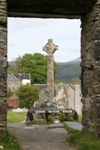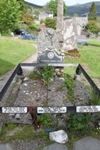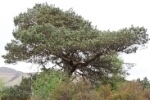 Rob Roy
Rob Roy
Robert "Rob Roy" MacGregor was the third son of Donald Glas MacGregor of Portnellan in Glen Gyle (number 1 on the map) and Margaret Campbell, a descendant of both the Campbells of Glen Orchy and Glen Lyon. He was the grandson of Callum MacGregor of Glengyle.
As he was born when the proscription of Clan Gregor had temporarily been lifted,
Rob was baptised 7th March 1671 and was registered in the parish records of Buchanan, a neighbouring parish of Callander (2).
When the proscription of Clan Gregor was reinstated, Rob Roy adopted the name Campbell.
He was married to Mary MacGregor of Comar and had four children: James, Coll, Ronald/Ranald and Robin Og.
He is reputed to have had exceptionally long arms (stretching below his knees). Forbes MacGregor describes him as follows: "He was audacious, and physically far above normal ability. He was also shrewd and knew when he had better use discretion. This part of his nature perhaps he derived from the Campbells for the MacGregors were not noted for being discreet."
Rob Roy was active in the cattle "business" from a very early age. One of his most notable exploits was the "Hership (a warlike raid, in this case to steal cattle) of Kippen" (a place between Loch Lomond and Stirling), when he drove off large numbers of sheep and cattle.
He continued in the black cattle trade and was quite successful at it, that is, until he wanted to expand and got a loan of £1,000 from the Duke of Montrose (a Graham). Unfortunately, his chief drover ran off with the money. Montrose charged him with theft and Rob Roy was declared an outlaw in 1713.
Montrose infuriated Rob Roy by throwing his wife and young sons out of the house in winter.
The Duke of Montrose and the Earl of Argyll were at odds with one another, so Rob Roy, being half-Campbell himself, found shelter with the Campbells.
He was caught twice by Montrose but managed to escape every time. With the permission of Argyll, he obtained land in Craig Royston (3), which served as an excellent point to conduct his campaigns of blackmail. It was during this period he obtained his "Robin Hood" status.
During the Jacobite Risings of 1715 and 1719, Rob Roy took over the leadership of Clan Gregor (! he was never Chief of Clan Gregor!). He surrendered to the English for his participation in these Risings, but escaped transportation to the West Indies.

 He lived the rest of his life in Balquhidder (4), where he died 28th December 1734, at the age of 63. You can visit his grave and that of his wife and two of his sons there. People still throw money on the grave which is left undisturbed.
He lived the rest of his life in Balquhidder (4), where he died 28th December 1734, at the age of 63. You can visit his grave and that of his wife and two of his sons there. People still throw money on the grave which is left undisturbed.
Already a legend during his own lifetime, he was immortalised by Sir Walter Scott in his novel "Rob Roy", first published in 1817.
Rob Roy has his own long-distance path, the Rob Roy Way, running either 124 km (77 miles) or 151 km (94 miles), from Dryman to Pitlochry.
Rob Roy's Family Tree
Malcolm Og (Callum) MacGregor of Glengyle was Rob Roy's grandfather.
He was married to a MacFarlane lady first, who gave him two or three sons. He left her for a MacDonald chief's daughter who gave him nine sons and daughters, including Donald, Rob Roy's father.
Callum led the force of MacGregors in Glen Fruin. But that was not his only notable feat. During the severest times of the Proscription, Callum tried to abduct an heiress, who just so happened to be a relative of the Earl of Argyll (the top Campbell). Obviously, Callum was high on the list of MacGregors Argyll wanted to arrest. So Argyll waited in a pub that Callum regularly visited. When inside, Argyll loudly wished he could arrest Callum, who was then standing outside. His gillie (a sort of servant) wanted to shoot Argyll, but Callum would not do such a cowardly act. He did write Argyll his exact words and in return, Argyll (temporarily?) ceased his hunt for Callum.
But there were still plenty of other Campbells hunting Callum.
On one occasion, Callum was chased by a Campbell bloodhound. Callum hid and managed to shoot the dog, after which he could freely escape, knowing the Campbells could not follow his trail. The hillock where he pulled that stunt is called Meall a Mhadaidh, the knoll of the dog, and it is found in Glen Ogle (between Glen Dochart and Lochearnhead).
Another time, he was hiding on an islet in Loch Katrine. The islet was barren so the Campbells thought they would simply starve him into surrender, and waited.
One of them started a fire to prepare some food. Callum was an excellent marksman and shot the guy from a great distance, shouting "Thugad thall a chrom thruaill sloightear", meaning something like "Get out of my way, you greasy crook". Crom has another meaning though, and can refer to a cobbler, which was the profession of the one Callum shot dead. The Campbells feared Calllum had second sight and would finish them off one by one, so they fled the scene.
Apparently, Callum managed to spend the rest of his life peacefully in Glen Gyle.
Lieutenant-Colonel Donald Glas MacGregor of Glengyle was Rob Roy's father. He was born in 1620/1630/1640 (depending on the source), but since he fathered the youngest of his bairns in 1671 and played a prominent part in a historic battle in 1689, my bet would not be 1620.
He was named after his maternal uncle and obtained the nickname Glas (pale) because of his pale skin. He acquired the rank of Lieutenant-Colonel in the army of Charles II. When William of Orange took the throne from James VII, Clan Gregor was asked by the exiled king to fight William of Orange. Donald led the clan (he was not chief, but a chieftain of the MacGregors) and fought under "Bonnie Dundee" at the Battle of Killiecrankie in 1689.
The Jacobites won, but Viscount Dundee took a bullet in the head and died. Without Dundee to gather all the clans, the Jacobite army was defeated. Donald was imprisoned and subjected to years of torture in Edinburgh's Tolbooth (all sources claim at the hands of Campbells). When he was finally released, he never recovered and died around 1695. His eldest son and heir (and Rob Roy's brother) John died a few years later.
James Mhor was Rob Roy's eldest son. He was born in 1694 and before his death in 1754, he fathered thirteen children, one of whom was Mary (Malie), whom I will get to later. As he lived in the era of the Clan Gregor Proscription, he first used the name Campbell (like Rob Roy), but then switched to Drummond.
Unlike his father, James Mhor seems to have had an uncontrollabe temper and had a reputation for scheming. Forbes MacGregor portrays him as follows: "He seemed never to be happy unless he was intriguing, and no person, perhaps not even himself, could guess what he would be planning next."
James was out with his brothers Ranald and Robin (Coll had died a year after his father in 1735) in the '45 Rising where he fought very valiantly at Prestonpans against the Hanoverian force. He was arrested for treason, but was pardoned. This could have been the beginning of a long and peaceful life, but peace was not part of James' nature.
James incited his brother Robin to combine marriage and fortune, so they abducted Jean Key and forced her to marry Robin.
For this offence James was arrested and detained in Edinburgh in 1750. He escaped because his daugther Malie (some sources say it was Elizabeth/Elspeth), who had dressed up as a cobbler, switched clothes with him and she took his place. James subsequently fled to France.
On his way to France, James is reputed to have done a deal with British agents to hand them Alan Breck Stewart, suspected as the one behind the Appin murder (when a Campbell was shot in 1752). Fact is that he had already given damning evidence to frame James Stewart (James of the Glen), whom everyone knew to be innocent, but a Campbell jury condemned him to death anyway. It was such a wonderful time if you're into savage murder stories. If you want to read up on that story, please read "The Appin Murder - The Killing of the Red Fox", by Seamus Carney.
Or you could read some fiction by Robert Louis Stevenson, as Alan Breck features in both Kidnapped and Catriona, and James Mhor heavily features in the latter as he is the father of Catriona.
James Mhor died in great poverty in Paris in 1754.
Ranald was also active in the '45 Rising, after which he was quite content to spend the rest of his life farming. He died in 1786.
Robin Og was the youngest of the family and not the most genteel character. He murdered a relative in 1736, but managed to escape death by joining the British army, where he was part of one of the biggest defeats the British Army had ever known to that date. He switched sides later to fight with the Jacobites (which proved equally unsuccessful, but he won more honour on that occasion).
For the abduction of Jean Key and the murder he was finally tried and hanged 14th February 1754. It is said the same Malie (James Mhor's daughter) prevented the hangman from taking the clothing from her uncle's body after which she had his body brought back to Balquhidder.
Malie/Mary is Rob Roy's granddaughter. As described above, she must have had a feisty and determined character, not only to take her father's place in prison, but also to boldly stop the hangman from undressing her dead uncle.
Malie's character was the basis for Robert Louis Stevenson's novel Catriona. In the book you will read how Catriona is the daughter of James Mhor Drummond, how she helps her father escape from Edinburgh prison and how she ends up with her father in Paris... until at long last she sees her father for what he really is and leaves him to be with David Balfour, the main character of the first book. Oh, romance, romance.
Oh, isn't it just too much of a coincidence that you can shorten Catriona to ... Carin?
Hip hip hurray for the Children of the Mist!
 Home
Home

